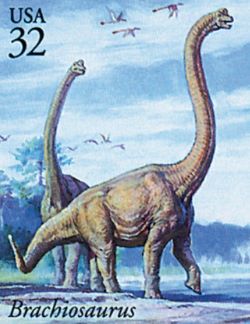
Image Copyright- US Postal Service
Brachiosaurus
| How big did it get? | Approximately 85 feet in length and 40 feet in height. |
| When did it live? | Late Jurassic period (about 154-153 million years ago). |
| Where did it live? | Fossils discovered in North America, Europe, and Africa. |
| What did it eat? | Herbivorous, primarily consuming vegetation from trees. |
| Interesting facts? | Towering over its Jurassic surroundings, Brachiosaurus was a massive, long-necked dinosaur with a small head and distinctive nostrils atop its skull. It was one of the largest land animals ever discovered, peacefully browsing on vegetation. |
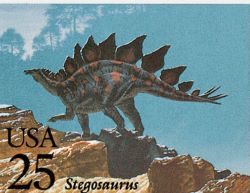
Image Copyright- US Postal Service
Stegosaurus
| How big did it get? | Around 30 feet in length and 14 feet in height. |
| When did it live? | Late Jurassic period (about 154-153 million years ago). |
| Where did it live? | Fossils discovered in North America, Europe, and Asia. |
| What did it eat? | Herbivorous, feeding on low-lying plants. |
| Interesting facts? | Stegosaurus had a double row of large bony plates along its back and four sharp spikes on its tail, possibly used for defense against predators. |
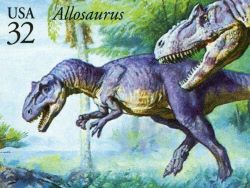
Image Copyright- US Postal Service
Allosaurus
| How big did it get? | Approximately 28 feet in length. |
| When did it live? | Late Jurassic period (around 155-150 million years ago). |
| Where did it live? | Fossils found in North America, Europe, and possibly Africa. |
| What did it eat? | Carnivorous, likely preying on herbivorous dinosaurs. |
| Interesting facts? | A fearsome predator of the Jurassic period, Allosaurus was a large theropod dinosaur with sharp teeth and a powerful jaw. It likely preyed on herbivorous dinosaurs and was a dominant carnivore in its ecosystem. |

Diplodicus
| How big did it get? | Approximately 90 feet in length. |
| When did it live? | Late Jurassic period (around 154-150 million years ago). |
| Where did it live? | Fossils found in North America. |
| What did it eat? | Herbivorous, feeding on vegetation with its long neck. |
| Interesting facts? | Characterized by its long neck and whip-like tail, Diplodocus was a herbivorous dinosaur that roamed the Jurassic landscapes. Despite its immense size, it was a gentle giant, using its lengthy neck to reach high vegetation. |
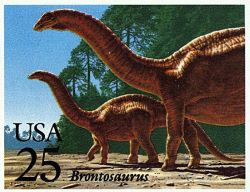
Image Copyright- US Postal Service
Brontosaurus
| How big did it get? | This massive dinosaur reached lengths of up to 75 feet, with a long neck and tail, and its body towering above the ground |
| When did it live? | Late Jurassic period (around 154-150 million years ago). |
| Where did it live? | Fossils found in North America. |
| What did it eat? | Brontosaurus was herbivorous, relying on its long neck to reach high vegetation and sustain itself on a diet of plants. |
| Interesting facts? | Brontosaurus was initially discovered and named by paleontologist Othniel Charles Marsh in the late 19th century. The name "Brontosaurus" means "thunder lizard." There was a period during which the existence of Brontosaurus as a separate genus was debated in paleontological circles, with some researchers suggesting that it should be classified as a species of Apatosaurus. However, recent studies have reinstated Brontosaurus as a distinct genus, recognizing its unique characteristics. The dinosaur's iconic long neck and massive size have made it a symbol of the grandeur of the Jurassic era. |
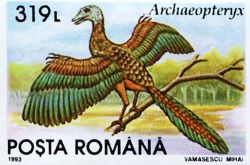
Archaeopteryx
| How big did it get? | About the size of a crow, roughly 1-2 feet in length. |
| When did it live? | Late Jurassic period (around 150 million years ago). |
| Where did it live? | Fossils found in Germany (Europe). |
| What did it eat? | Carnivorous, likely feeding on small insects and other prey. |
| Interesting facts? | Archaeopteryx is considered a transitional fossil between dinosaurs and birds, displaying both reptilian and avian features. It had feathered wings but also teeth in its beak. |
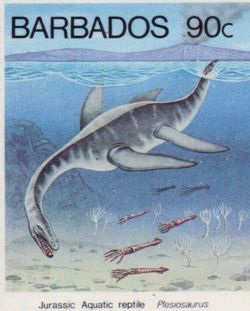
Plesiosaurus
| How big did it get? | Plesiosaurus was a marine reptile with a sleek, elongated body and a relatively small head. It measured around 10 to 15 feet in length, with some species possibly reaching larger sizes. |
| When did it live? | Plesiosaurus existed during the Mesozoic Era, specifically the Jurassic period, around 201 to 145 million years ago. |
| Where did it live? | Fossils of Plesiosaurus have been found in various locations, including Europe, South America, and North America. The discovery of its fossils in marine deposits suggests a widespread distribution in ancient seas. |
| What did it eat? | Plesiosaurus was carnivorous, preying on fish and other marine creatures. Its sharp, pointed teeth were well-suited for catching and consuming its aquatic prey. |
| Interesting facts? | Plesiosaurus is characterized by its long neck, which sets it apart from other marine reptiles. It had a streamlined body, paddle-like limbs, and likely used its four flippers for efficient swimming. Despite its somewhat serpentine appearance, Plesiosaurus was not a dinosaur but belonged to a group of marine reptiles known as plesiosaurs. The structure of its limbs and body suggest that Plesiosaurus was well-adapted for a semi-aquatic lifestyle, spending much of its time in the open ocean. |
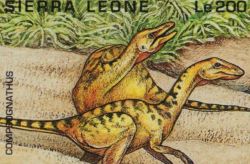
Compsognathus
| How big did it get? | This small, bipedal dinosaur measured approximately 3.3 feet in length, making it one of the smaller theropods of its time. |
| When did it live? | Compsognathus existed during the Late Jurassic period, around 150 million years ago. |
| Where did it live? | Fossils of Compsognathus have been found in Europe, with notable discoveries in Germany and France. |
| What did it eat? | Compsognathus was carnivorous, likely preying on smaller animals such as insects, lizards, and possibly small mammals. |
| Interesting facts? | Compsognathus is renowned for its slender build, long legs, and agile nature, traits that suggest it was a swift and nimble predator. Its name, meaning "elegant jaw," reflects the streamlined appearance of its skull. Despite its small size, Compsognathus was likely a proficient hunter, using its speed and agility to pursue prey. Fossil evidence suggests that Compsognathus had feathers, providing valuable insights into the evolution of feathers in theropod dinosaurs. |